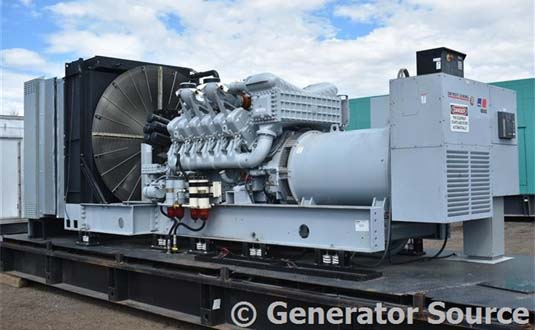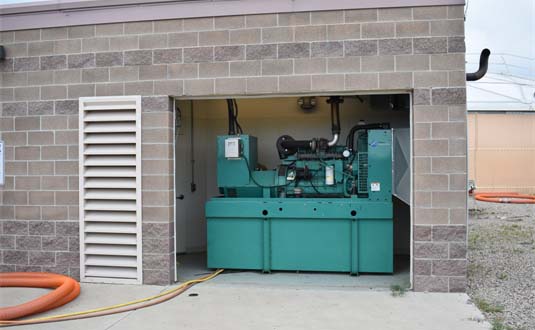|
Generators – Installation, Safety Precautions and Regular Maintenance Schedule
 Standby generators are an inevitable requirement to combat power outages and overcome the resultant hindrances to business continuity. While generators are convenient and easy to use, with most of them being capable of automatic functioning during power outages, they can also be hazardous to life and property if standard procedures and adequate precautions are not followed during installation, operation and maintenance. This article covers general topics to be aware of. Standby generators are an inevitable requirement to combat power outages and overcome the resultant hindrances to business continuity. While generators are convenient and easy to use, with most of them being capable of automatic functioning during power outages, they can also be hazardous to life and property if standard procedures and adequate precautions are not followed during installation, operation and maintenance. This article covers general topics to be aware of.
Generator Source always recommends using a certified technician or electrician for any type of work on a power generator. This article provides general tips and guidelines only, best practice always suggests consulting the manufacturer and owner’s manual to ensure unit specific guidelines are followed and the generator is operated in a safe working environment.
Selecting a Generator
1. In the case of a portable generator, only a limited number of appliances can be energized in the event of a power failure. It is essential to determine the ‘constant wattage’ which is the sum total of the wattages of each individual appliance that you seek to keep functional.
2. Motor driven appliances like refrigerators and air-conditioners require power as much as three times their constant wattage at the time of starting up. The chosen generator should meet or exceed the ‘constant wattage’ rating and have a ‘surge rating’ that exceeds the ‘start-up wattage’ requirements.
3. Voltage ratings of the equipment and the appliances that you wish to operate should be
matched.
Installation Procedures
Equipments should always be installed, serviced and repaired only by Authorized Service Dealers, or competent, qualified and certified technicians who have a thorough knowledge of and always comply with standard operating procedures, applicable codes and regulations. The National Fire Protection Association (NFPA) has published several booklets on standards pertaining to standby electric systems. NFPA 110 provides important information on ‘Standards for Emergency and Standby Power Systems’. It is essential to check whether the generator and its accessories comply with the latest version of any standards as applicable to the equipment.
1. Upon unpacking the generator from shipping cartons, first conduct a thorough inspection to detect any damage that may have occurred during shipment.
2. Check whether the rated amperage / wattage capacity of the unit is adequate to handle all the intended loads during a power outage. If required, the critical loads may be grouped together and wired independently into an exclusive distribution panel.
3. The unit should be placed outdoors in a protective enclosure, where sufficient air for cooling and ventilation is available in an unobstructed manner. The generator should be placed on a level surface, which is non-combustible and non-conducting, a little above ground level to prevent contact from rising water levels.
4. The generator should be installed in close proximity to the location of the transfer switch and the fuel supply, to reduce the required length of cabling and piping respectively. You may be required to seek a permit if you intend to store a large fuel tank. The fuel pipe sizing, construction and layout must comply with NFPA 54 for natural gas applications and NFPA 58 for liquid propane applications.
5. A grounding lug is usually provided for grounding the frame and external conducting parts of the equipment. It is essential to consult a qualified electrician to determine grounding requirements and follow procedures that meet local regulations.
6. All batteries must be completely charged before they are inserted into the generator.
7. Similar care must be ensured while unpacking and installing the transfer switch. The switch should be wall-mounted and all the points must be in level with each other to prevent distortion of the switch.
8. The unit should be connected to the electrical system supplied by the utility only by means of the automatic transfer switch. This will ensure isolation between the generator’s electric system and the utility distribution system. Also, back-feed can occur wherein an improperly connected generator begins to feed electricity back into the power lines which will damage the unit and cause injury or death to the operating personnel. In the absence of a transfer switch, the safest option is to plug the essential appliances directly into the generator.
Safety Precautions
General Hazards
1. Installation, repair and maintenance should always be in accordance with the manufacturer’s instructions and recommendations.
2. Exhaust fumes emitted by generator sets contain poisonous gases like carbon monoxide that can be life threatening and result in death. Exhaust systems must be properly installed, adequate ventilation must be provided to ensure unobstructed flow of cooling and ventilating air, and emissions must be directed away from inhabited zones.
3. The area around the generator must be clean and free of clutter and any combustible material that can be hazardous.
4. The equipment must be regularly inspected and defective or damaged parts must be replaced in a timely manner.
5. It is essential that the operating personnel remains alert at all times while working with the generator.
6. The unit should not be opened or dismantled while it is functioning. Moving or hot parts should not be tampered with. Battery cables should be disconnected before proceeding to work on the generator to eliminate any possibility of an accidental start-up.
Electrical Hazards
1. All power voltage supplies should be turned off at the source while installing or servicing the generator.
2. All electrical connections, such as wires, cables and terminals must be properly insulated and covered, and should not be touched with bare hands or while in contact with water. This is essential to prevent the occurrence of an electric shock.
3. The frame of the generator and any external conducting parts should have proper grounding / earthing wiring. This should never be disconnected.
4. Wiring, cable and cord sets must be of the recommended capacity.
Fire and Explosion Hazards
1. Smoking in the vicinity of the equipment can be fatal.
2. Fuel or oil spills around the generator, leakages from the unit’s fuel system and fuel supply lines, and presence of combustible materials around the generator will pose a risk of an explosion.
3. A fire extinguisher should be readily available. Use of extinguishers that operate on carbon tetra-chloride is strictly prohibited since the fumes are toxic and can deteriorate the insulation on the wiring of generators.
Regular Maintenance Schedules
Annual, semi-annual or quarterly maintenance schedules ought to be strictly followed to increase the reliability of the equipment. When the unit is inspected and exercised regularly, it continues to deliver consistent output as per expectations. Proactive maintenance also helps in detecting damages and defects at an early stage allowing preventive measures to be taken in a timely fashion. Given below is a short list of parts and components that need to be inspected and updated or changed regularly. For additional maintenance information you can also check out our generator maintenance article.
1. Cooling system for radiator air restriction, hoses, connections, fluid concentration, belts and louver operation
2. Air intake system for leakages and loose connections
3. Air cleaner, turbocharger, muffler, traps
4. Fuel system for fuel levels, sediments, and proper functioning of the pump
5. Exhaust system for leaks, chokes and flush condensation cap
6. Electrical system to review meters and batteries to be recharged, if required
7. Change oil and filters annually.
8. Diodes, end bearing, brushes and folder, A.C. wiring, exciter stator, over-speed switch and breakers
9. Controls like voltage regulator, wiring, relays, monitors and bulbs
10. Transfer switch for time delays and exerciser clocks to be adjusted or reset
11. Performance parameters such as A.C. output and frequency
While the above are only generic guidelines to be followed for a safe and effective use of the equipment, it is very essential for the user to strictly abide by all the guidelines and instructions detailed in the manual. A few, simple precautions can go a long way in ensuring a safe and optimum use of the product.
>>Back to Articles & Info<<
|